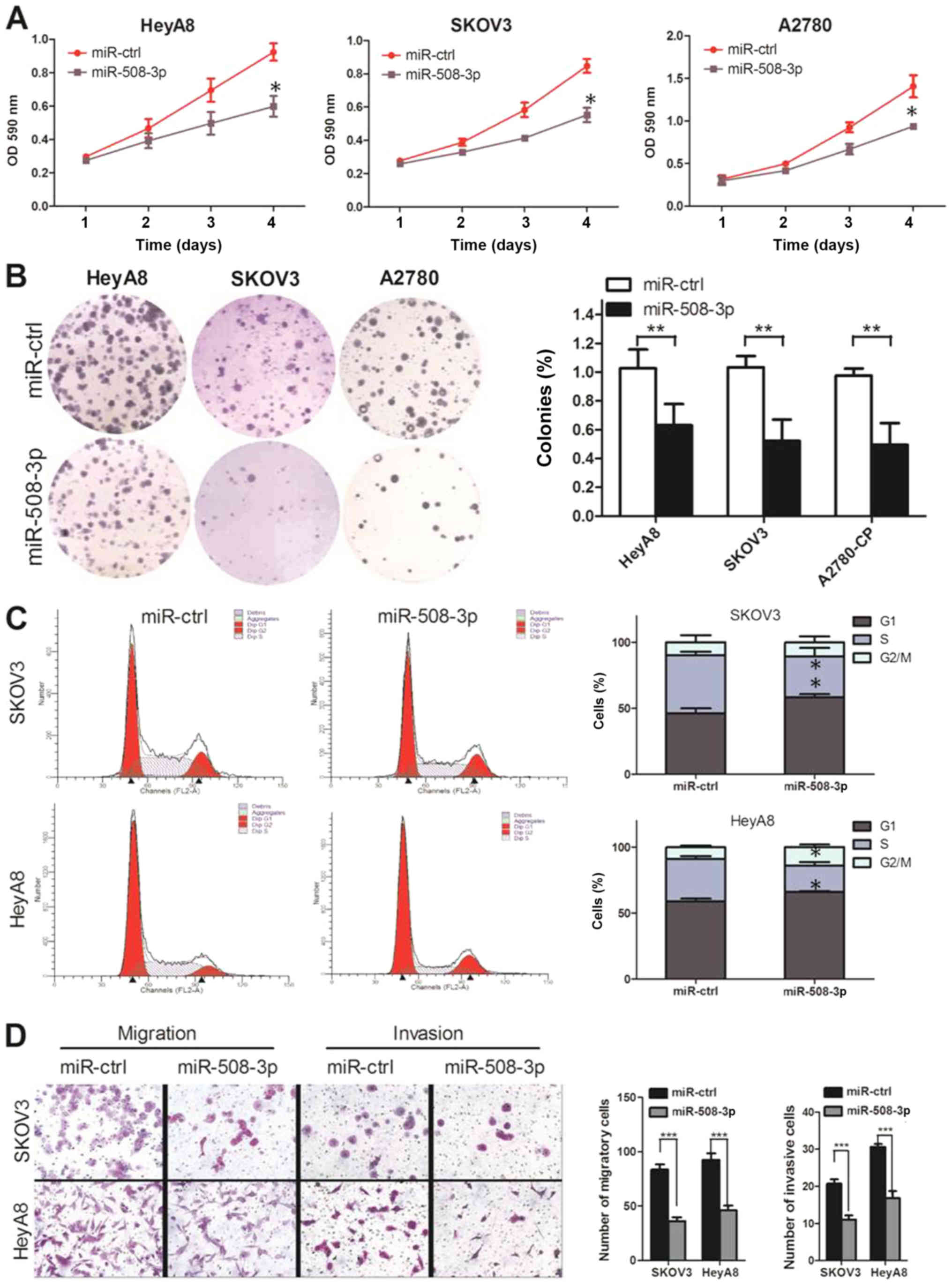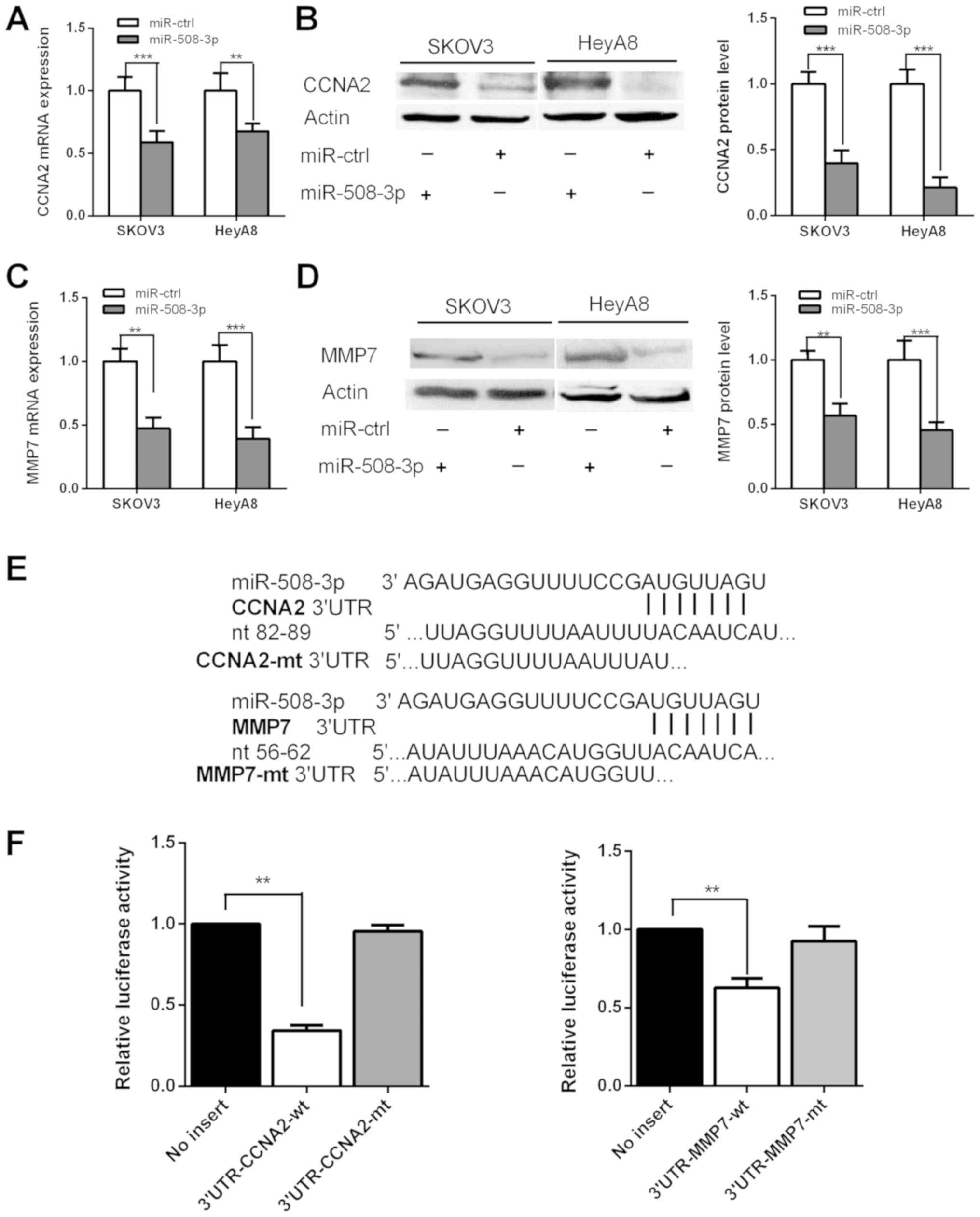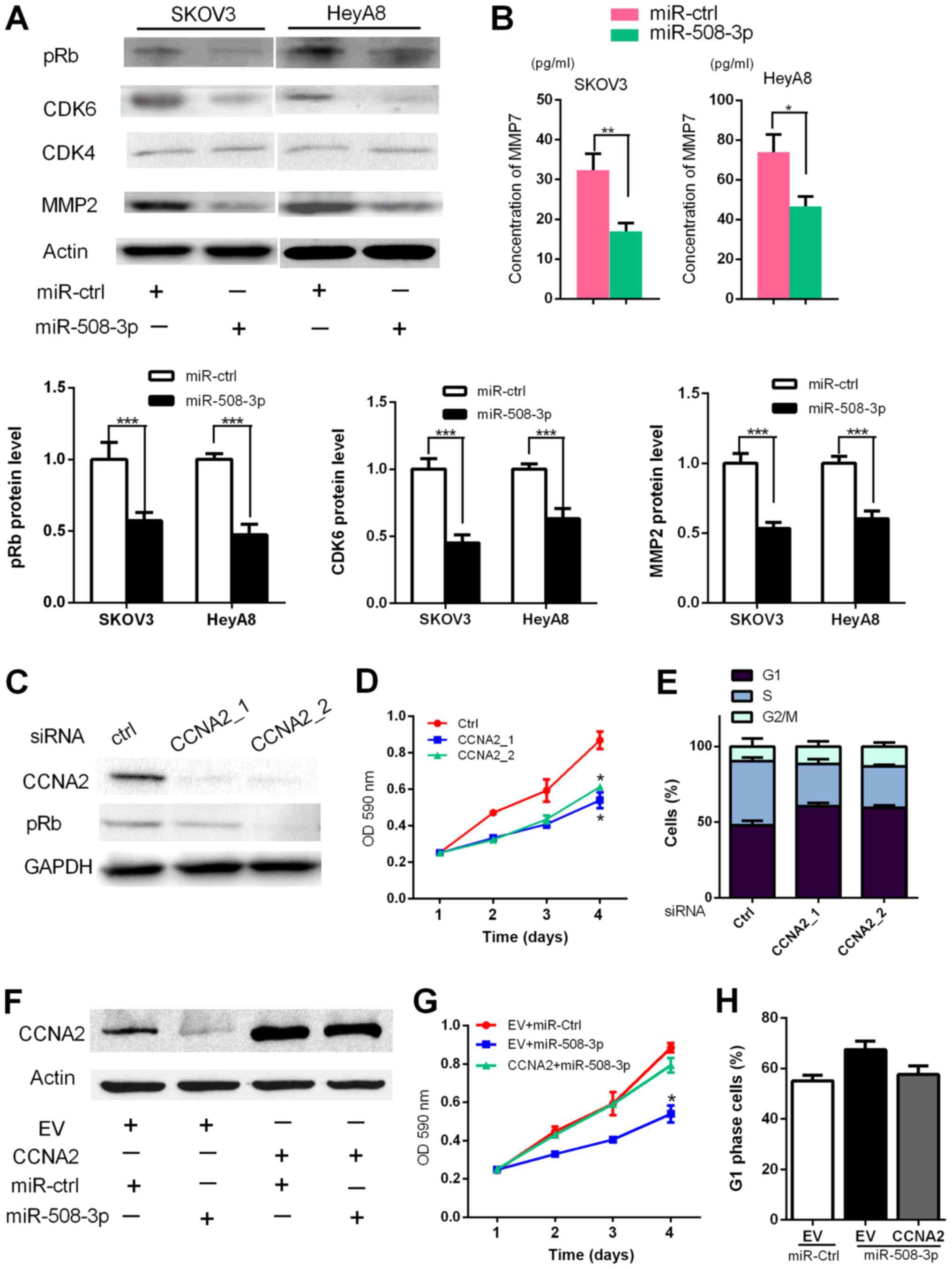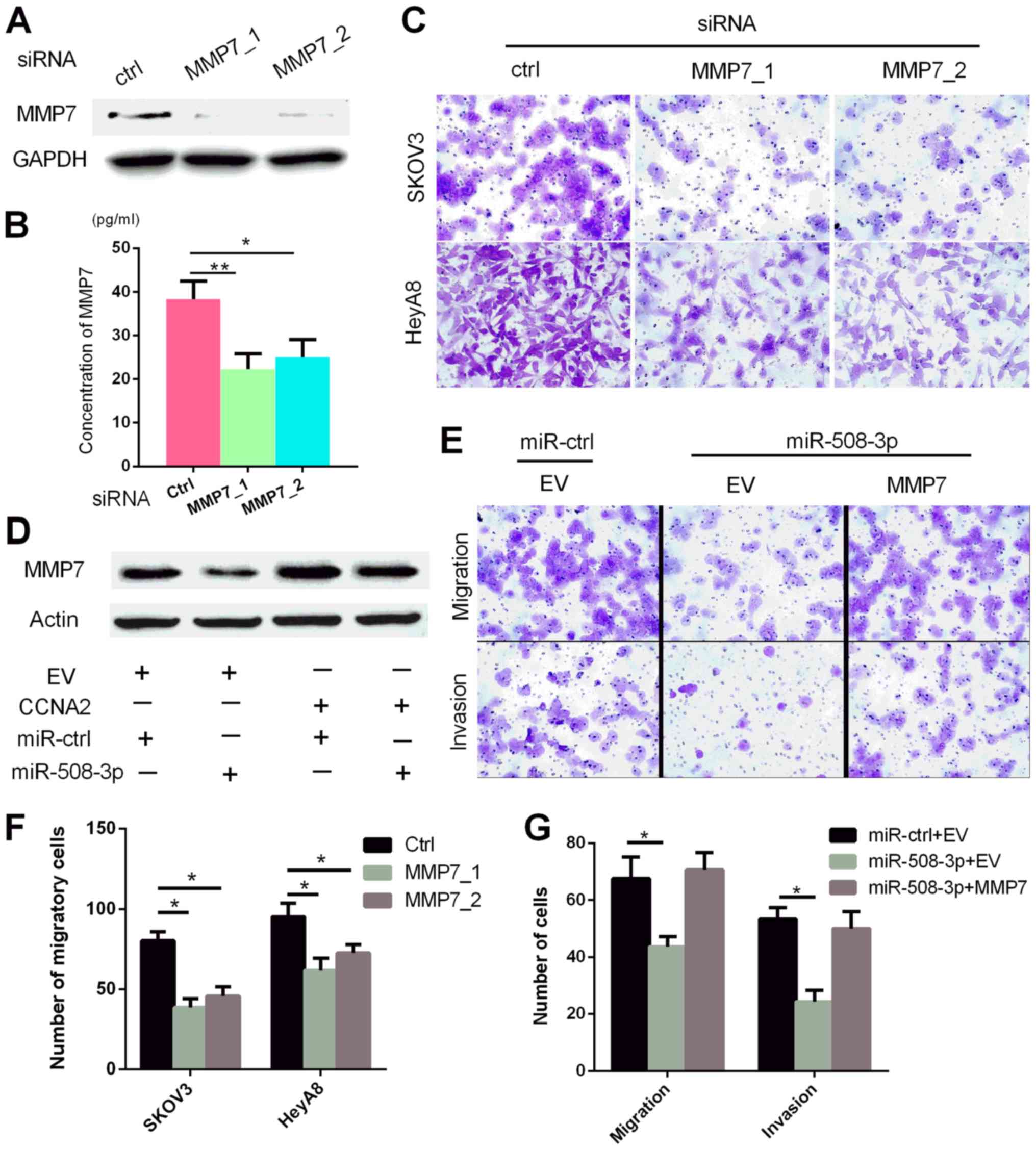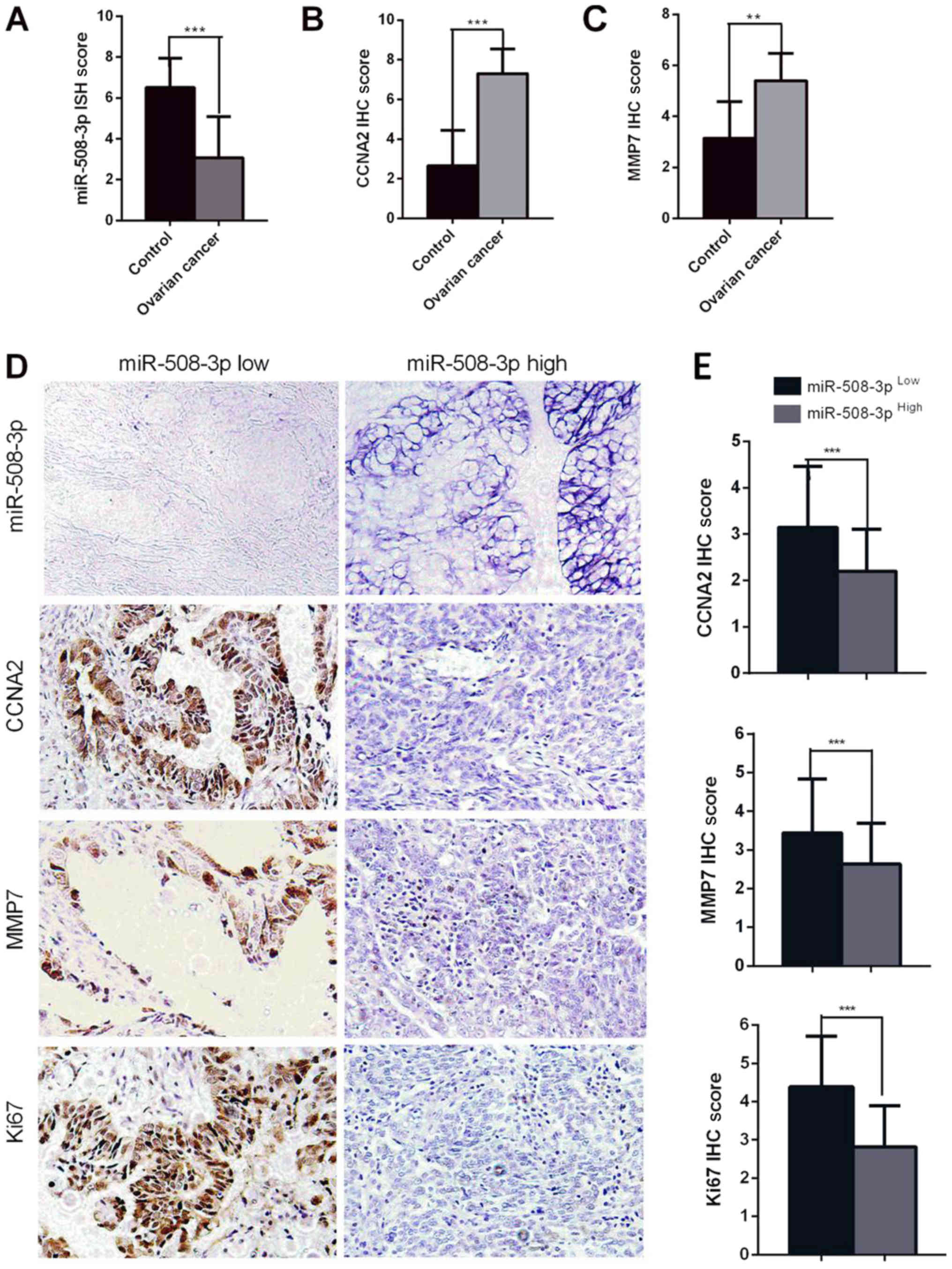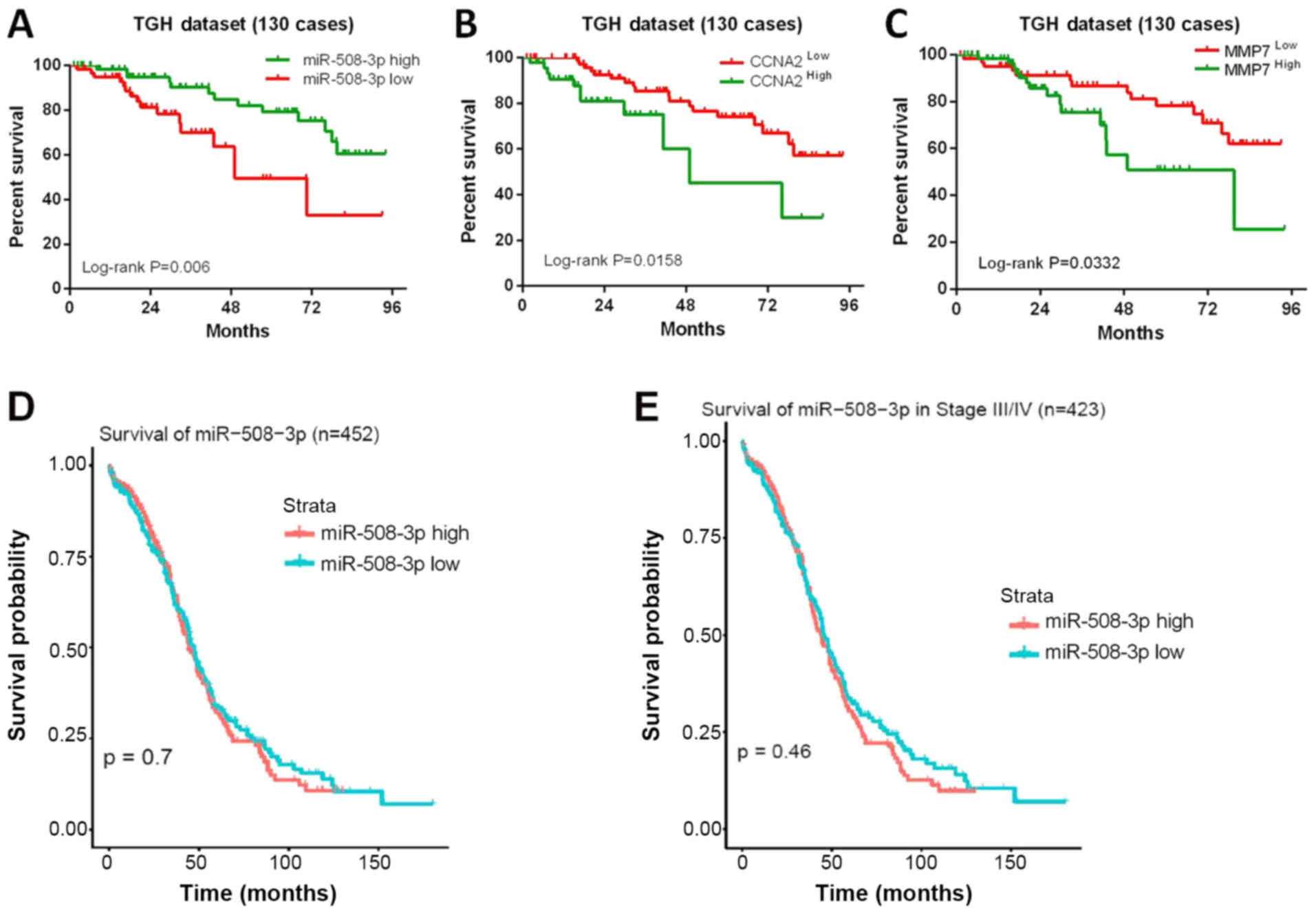|
1
|
Siegel RL, Miller KD and Jemal A: Cancer
Statistics, 2017. CA Cancer J Clin. 67:7–30. 2017. View Article : Google Scholar : PubMed/NCBI
|
|
2
|
Chen W, Zheng R, Baade PD, Zhang S, Zeng
H, Bray F, Jemal A, Yu XQ and He J: Cancer statistics in China,
2015. CA Cancer J Clin. 66:115–132. 2016. View Article : Google Scholar : PubMed/NCBI
|
|
3
|
Nasioudis D, Kahn R, Chapman-Davis E, Frey
MK, Caputo TA, Witkin SS and Holcomb K: Impact of hospital surgical
volume on complete gross resection (CGR) rates following primary
debulking surgery for advanced stage epithelial ovarian carcinoma.
Gynecol Oncol. 154:401–404. 2019. View Article : Google Scholar : PubMed/NCBI
|
|
4
|
Rojas V, Hirshfield KM, Ganesan S and
Rodriguez-Rodriguez L: Molecular Characterization of Epithelial
Ovarian Cancer: Implications for Diagnosis and Treatment. Int J Mol
Sci. 17:172016. View Article : Google Scholar
|
|
5
|
Allemani C, Weir HK, Carreira H, Harewood
R, Spika D, Wang XS, Bannon F, Ahn JV, Johnson CJ, Bonaventure A,
et al CONCORD Working Group: Global surveillance of cancer survival
1995-2009: Analysis of individual data for 25,676,887 patients from
279 population-based registries in 67 countries (CONCORD-2).
Lancet. 385:977–1010. 2015. View Article : Google Scholar
|
|
6
|
Zhai Q, Zhou L, Zhao C, Wan J, Yu Z, Guo
X, Qin J, Chen J and Lu R: Identification of miR-508-3p and
miR-509-3p that are associated with cell invasion and migration and
involved in the apoptosis of renal cell carcinoma. Biochem Biophys
Res Commun. 419:621–626. 2012. View Article : Google Scholar : PubMed/NCBI
|
|
7
|
Yu X, Zhang X, Bi T, Ding Y, Zhao J, Wang
C, Jia T, Han D, Guo G, Wang B, et al: MiRNA expression signature
for potentially predicting the prognosis of ovarian serous
carcinoma. Tumour Biol. 34:3501–3508. 2013. View Article : Google Scholar : PubMed/NCBI
|
|
8
|
Hidaka H, Seki N, Yoshino H, Yamasaki T,
Yamada Y, Nohata N, Fuse M, Nakagawa M and Enokida H: Tumor
suppressive microRNA-1285 regulates novel molecular targets:
Aberrant expression and functional significance in renal cell
carcinoma. Oncotarget. 3:44–57. 2012. View Article : Google Scholar : PubMed/NCBI
|
|
9
|
Huang T, Kang W, Zhang B, Wu F, Dong Y,
Tong JH, Yang W, Zhou Y, Zhang L, Cheng AS, et al: miR-508-3p
concordantly silences NFKB1 and RELA to inactivate canonical NF-κB
signaling in gastric carcinogenesis. Mol Cancer. 15:92016.
View Article : Google Scholar
|
|
10
|
Yamamoto S, Tsuda H, Miyai K, Takano M,
Tamai S and Matsubara O: Cumulative alterations of p27-related
cell-cycle regulators in the development of
endometriosis-associated ovarian clear cell adenocarcinoma.
Histopathology. 56:740–749. 2010. View Article : Google Scholar : PubMed/NCBI
|
|
11
|
Lee YH, Heo JH, Kim TH, Kang H, Kim G, Kim
J, Cho SH and An HJ: Significance of cell cycle regulatory proteins
as malignant and prognostic biomarkers in ovarian epithelial
tumors. Int J Gynecol Pathol. 30:205–217. 2011. View Article : Google Scholar : PubMed/NCBI
|
|
12
|
Song N, Liu H, Ma X and Zhang S: Placental
growth factor promotes metastases of ovarian cancer through
miR-543-regulated MMP7. Cell Physiol Biochem. 37:1104–1112. 2015.
View Article : Google Scholar : PubMed/NCBI
|
|
13
|
Yu B, Liu X and Chang H: MicroRNA-143
inhibits colorectal cancer cell proliferation by targeting MMP7.
Minerva Med. 108:13–19. 2017.
|
|
14
|
Berek JS, Crum C and Friedlander M: Cancer
of the ovary, fallopian tube, and peritoneum. Int J Gynaecol
Obstet. 119(Suppl 2): S118–S129. 2012. View Article : Google Scholar : PubMed/NCBI
|
|
15
|
Yang D, Sun Y, Hu L, Zheng H, Ji P, Pecot
CV, Zhao Y, Reynolds S, Cheng H, Rupaimoole R, et al: Integrated
analyses identify a master microRNA regulatory network for the
mesenchymal subtype in serous ovarian cancer. Cancer Cell.
23:186–199. 2013. View Article : Google Scholar : PubMed/NCBI
|
|
16
|
Parker BC, Annala MJ, Cogdell DE, Granberg
KJ, Sun Y, Ji P, Li X, Gumin J, Zheng H, Hu L, et al: The
tumorigenic FGFR3-TACC3 gene fusion escapes miR-99a regulation in
glioblastoma. J Clin Invest. 123:855–865. 2013.PubMed/NCBI
|
|
17
|
Zarkowska T, U S, Harlow E and Mittnacht
S: Monoclonal antibodies specific for underphosphorylated
retinoblastoma protein identify a cell cycle regulated
phosphorylation site targeted by CDKs. Oncogene. 14:249–254. 1997.
View Article : Google Scholar : PubMed/NCBI
|
|
18
|
Wang X, Hu Y, Cui J, Zhou Y and Chen L:
Coordinated targeting of MMP-2/MMP-9 by miR-296-3p/FOXCUT exerts
tumor-suppressing effects in choroidal malignant melanoma. Mol Cell
Biochem. 445:25–33. 2018. View Article : Google Scholar
|
|
19
|
Sun Y, Hu L, Zheng H, Bagnoli M, Guo Y,
Rupaimoole R, Rodriguez-Aguayo C, Lopez-Berestein G, Ji P, Chen K,
et al: miR-506 inhibits multiple targets in the
epithelial-to-mesenchymal transition network and is associated with
good prognosis in epithelial ovarian cancer. J Pathol. 235:25–36.
2015. View Article : Google Scholar
|
|
20
|
Liu G, Sun Y, Ji P, Li X, Cogdell D, Yang
D, Parker Kerrigan BC, Shmulevich I, Chen K, Sood AK, et al:
miR-506 suppresses proliferation and induces senescence by directly
targeting the CDK4/6-FOXM1 axis in ovarian cancer. J Pathol.
233:308–318. 2014. View Article : Google Scholar : PubMed/NCBI
|
|
21
|
Sun Y, Guo F, Bagnoli M, Xue FX, Sun BC,
Shmulevich I, Mezzanzanica D, Chen KX, Sood AK, Yang D, et al: Key
nodes of a microRNA network associated with the integrated
mesen-chymal subtype of high-grade serous ovarian cancer. Chin J
Cancer. 34:28–40. 2015. View Article : Google Scholar : PubMed/NCBI
|
|
22
|
Lin C, Liu A, Zhu J, Zhang X, Wu G, Ren P,
Wu J, Li M, Li J and Song L: miR-508 sustains phosphoinositide
signalling and promotes aggressive phenotype of oesophageal
squamous cell carcinoma. Nat Commun. 5:46202014. View Article : Google Scholar : PubMed/NCBI
|
|
23
|
Cribier A, Descours B, Valadão AL,
Laguette N and Benkirane M: Phosphorylation of SAMHD1 by cyclin
A2/CDK1 regulates its restriction activity toward HIV-1. Cell Rep.
3:1036–1043. 2013. View Article : Google Scholar : PubMed/NCBI
|
|
24
|
Das E, Jana NR and Bhattacharyya NP:
MicroRNA-124 targets CCNA2 and regulates cell cycle in
STHdh(Q111)/Hdh(Q111) cells. Biochem Biophys Res Commun.
437:217–224. 2013. View Article : Google Scholar : PubMed/NCBI
|
|
25
|
van Olphen SH, Ten Kate FJ, Doukas M,
Kastelein F, Steyerberg EW, Stoop HA, Spaander MC, Looijenga LH,
Bruno MJ, Biermann K and ProBar-Study Group: value of cyclin A
immunohistochemistry for cancer risk stratification in Barrett
esophagus surveillance: A multicenter case-control study. Medicine
(Baltimore). 95:e54022016. View Article : Google Scholar
|
|
26
|
Cooper WA, Kohonen-Corish MR, McCaughan B,
Kennedy C, Sutherland RL and Lee CS: Expression and prognostic
significance of cyclin B1 and cyclin A in non-small cell lung
cancer. Histopathology. 55:28–36. 2009. View Article : Google Scholar : PubMed/NCBI
|
|
27
|
Nozoe T, Inutsuka S, Honda M, Ezaki T and
Korenaga D: Clinicopathologic significance of cyclin A expression
in colorectal carcinoma. J Exp Clin Cancer Res. 23:127–133.
2004.PubMed/NCBI
|
|
28
|
Gopinathan L, Tan SL, Padmakumar VC,
Coppola V, Tessarollo L and Kaldis P: Loss of Cdk2 and cyclin A2
impairs cell proliferation and tumorigenesis. Cancer Res.
74:3870–3879. 2014. View Article : Google Scholar : PubMed/NCBI
|
|
29
|
Srethapakdi M, Liu F, Tavorath R and Rosen
N: Inhibition of Hsp90 function by ansamycins causes retinoblastoma
gene product-dependent G1 arrest. Cancer Res. 60:3940–3946.
2000.PubMed/NCBI
|
|
30
|
Xu J, e C, Yao Y, Ren S, Wang G and Jin H:
Matrix metalloproteinase expression and molecular interaction
network analysis in gastric cancer. Oncol Lett. 12:2403–2408. 2016.
View Article : Google Scholar : PubMed/NCBI
|
|
31
|
Klupp F, Neumann L, Kahlert C, Diers J,
Halama N, Franz C, Schmidt T, Koch M, Weitz J, Schneider M, et al:
Serum MMP7, MMP10 and MMP12 level as negative prognostic markers in
colon cancer patients. BMC Cancer. 16:4942016. View Article : Google Scholar : PubMed/NCBI
|
|
32
|
Zhu R and Tian Y: Astrocyte elevated
gene-1 increases invasiveness of NSCLC through up-regulating MMP7.
Cell Physiol Biochem. 37:1187–1195. 2015. View Article : Google Scholar : PubMed/NCBI
|
|
33
|
Maurel J, Nadal C, Garcia-Albeniz X,
Gallego R, Carcereny E, Almendro V, Mármol M, Gallardo E, Maria
Augé J, Longarón R, et al: Serum matrix metalloproteinase 7 levels
identifies poor prognosis advanced colorectal cancer patients. Int
J Cancer. 121:1066–1071. 2007. View Article : Google Scholar : PubMed/NCBI
|
|
34
|
Niedworok C, Tschirdewahn S, Reis H,
Lehmann N, Szucs M, Nyirady P, Romics I, Rubben H and Szarvas T:
serum chromogranin a as a complementary marker for the prediction
of prostate cancer-specific survival. Pathol Oncol Res. 23:643–650.
2017. View Article : Google Scholar
|
|
35
|
Zhang Q, Liu S, Parajuli KR, Zhang W,
Zhang K, Mo Z, Liu J, Chen Z, Yang S, Wang AR, et al:
Interleukin-17 promotes prostate cancer via MMP7-induced
epithelial-to-mesenchymal transition. Oncogene. 36:687–699. 2017.
View Article : Google Scholar :
|
|
36
|
Zhao L, Wang W, Xu L, Yi T, Zhao X, Wei Y,
Vermeulen L, Goel A, Zhou S and Wang X: Integrative network biology
analysis identifies miR-508-3p as the determinant for the
mesenchymal identity and a strong prognostic biomarker of ovarian
cancer. Oncogene. 38:2305–2319. 2019. View Article : Google Scholar :
|
|
37
|
Li HP, Ji JF, Hou KY, Lei YT, Zhao HM,
Wang J, Zheng J, Liu JY, Wang MP, Xiao Y, et al: Prediction of
recurrence risk in early breast cancer using human epidermal growth
factor 2 and cyclin A2. Chin Med J (Engl). 123:431–437. 2010.
|















